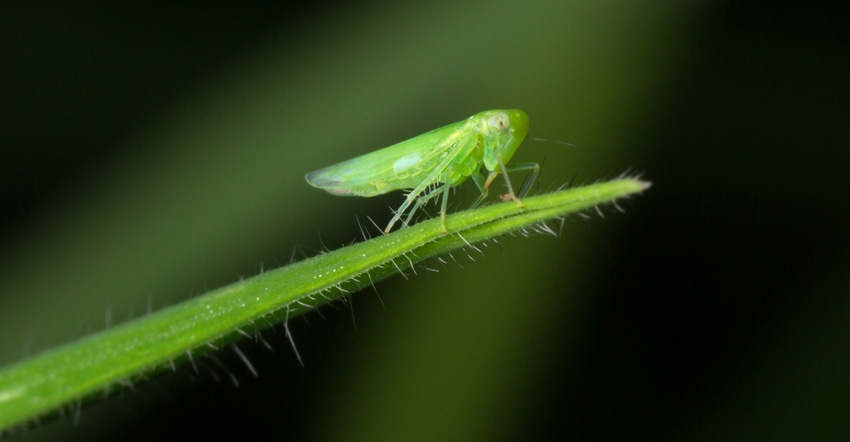June 22, 2021

Potato leafhopper is the worst pest of alfalfa, and if severe, it can reduce yield and quality — especially lowering protein content.
Right now is the time to be on the lookout for these critters as they’ve arrived in the region, according to many sources.
Potato leafhoppers are migratory, arriving here each spring on storm fronts. Once potato leafhoppers colonize alfalfa fields, the adults deposit eggs into stems and leaf veins. In warm weather, these eggs will develop into adults in about three weeks, so populations can increase quickly.
Potato leafhoppers have strawlike mouthparts and extract plant juices. Heavy feeding disrupts nutrient flow within plants, causing yellow triangles to form at the leaflet tips (hopper burn) in about seven to 10 days. As feeding continues, damage gets worse, and the chlorotic areas spread toward the base of the leaflet. Once hopper burn is evident, economic loss has occurred.
Pyrethroids offer the best control when things get out of control, but scouting is also key. Usually only one insecticide application is needed to control potato leafhopper all season, but only do it if the infestation justifies it and it’s economical.
When to scout
For new spring seedings, start sampling when the plants are 3 inches high, and resample every week until the field is sprayed or 10 days before harvest.
For new summer seedings, sample when plants are 2 inches high, and resample every week until mid-September.
For second and third cuttings, sample when plant regrowth is 2 to 3 inches, and resample every week until the field is sprayed, or 10 days before harvest.
How to scout
In square or rectangular fields, follow a "U" pattern. In narrow strips, an "I" pattern works best. Sample five sites in each, when alfalfa is dry, and avoid sampling in cold or windy weather.
Make 20 pendulum sweeps (100 sweeps total) with the net at each site, sweeping 3 to 4 inches below the tops of the plants. Don't stop swinging until you complete 20 sweeps. Collect samples from each site following a zigzag pattern, and take one or two steps between each sweep.
When you complete 20 sweeps, continue swinging the net several times to force the insects into the small end of the bag. Grab the bag about 10 inches from the small end of the bag.
Only count the pale green (nymphs are yellowish green) leafhoppers and disregard any brown ones.
Be alert because adult leafhoppers are very active and can easily escape without being noticed. Unfold the net slowly and let the insects escape a few at a time, counting them as they appear. Be careful to check the interior walls of the net for nymphs. They cannot fly and will be walking or clinging to the cloth.
Count the total number of leafhoppers. Repeat the same procedure at the next four sites, which completes your 100 sweeps of the field.
Calculate the average number of leafhoppers per sweep. For example, if you collected a total of 60 leafhoppers, find the average per sweep by dividing 60 by 100, which equals 0.6 leafhopper.
When the leafhopper population is high (40 or more in 20 sweeps) at the first site, spending time sampling the other four sites is of little value.
Make a sweep net
A sweep net is necessary to monitor potato leafhopper populations in a field. Insect nets can be purchased for about $15, but they are not widely available. Materials to make a net can be found on most farms.
Use a solid piece of wood about three-quarters inch in diameter and 2.5 to 3 feet long as the handle. A broom handle cut to length is suitable.
The hoop can be a piece of heavy-gauge wire or thin steel rod. You need a piece 53 inches long. Securely fasten the ends of the hoop to the wooden handle by tightly wrapping them together with light wire, such as baling wire or by slipping a metal sleeve onto the handle and over the hoop ends.
To make the net, you need two pieces of cloth measuring 24 by 36 inches. Heavy muslin or tightly woven nylon cloth will do.
Prepare for next year
Resistant varieties of alfalfa are available. These varieties are covered with fine hairs (glandular trichomes) that decrease leafhopper feeding.
Another option is to mix other forages in with alfalfa. Alfalfa or orchardgrass stands (or other combinations) are better at tolerating leafhopper damage than pure stands of alfalfa.
Spiders and other natural enemies kill potato leafhoppers, so using integrated pest management and spraying insecticides only when economic populations develop will help maintain these allies in pest control.
You May Also Like




